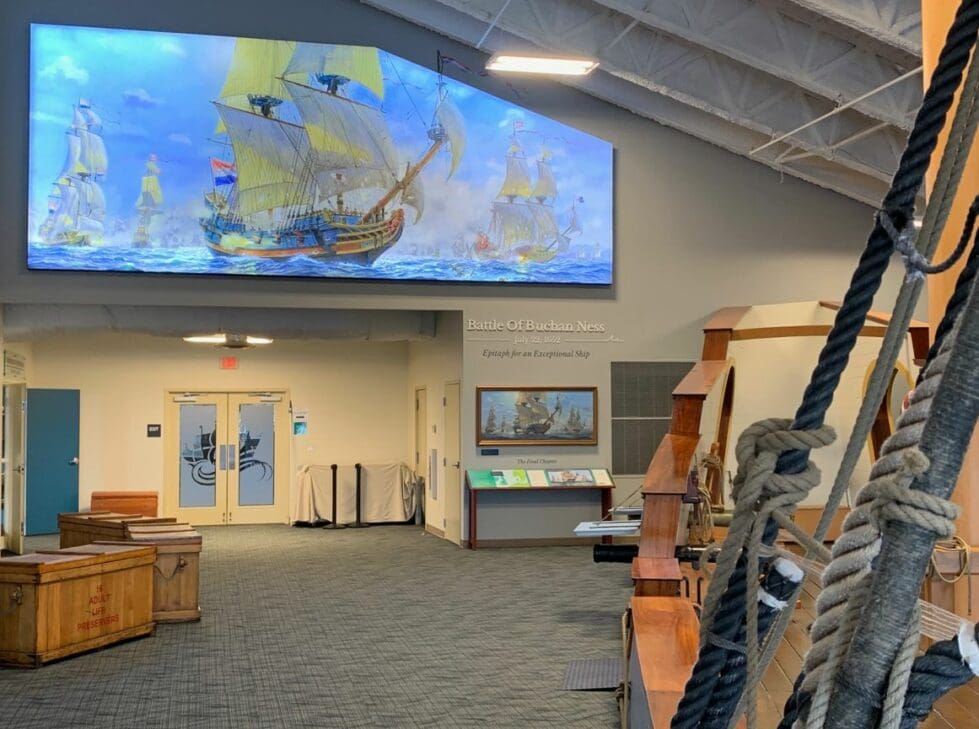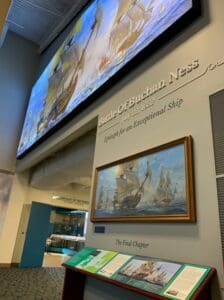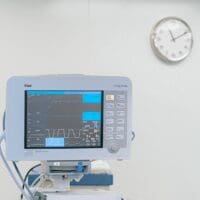

A painting detailing the last battle of Delaware’s tall ship, the Kalmar Nyckel, went on public display Saturday.
The Kalmar Nyckel Foundation newest exhibit focuses on Delaware’s tall ship in the 1652 battle in which it sank.
The exhibit includes a newly commissioned oil painting by well-respected Baltimore artist Patrick O’Brien that is hung at head level on a second-floor wall in the Copeland Maritime Center, along with information about the battle between the Dutch and the English.
The painting becomes a wall-sized exhibit directly above, shown on a 10-foot-by-24-foot backlit light box that add a sense of drama to the Main Deck room while letting the viewer feel the power of the art.
The final battle painting, dubbed “Battle of Buchan Ness: Epitaph for an Exceptional Ship,” has its genesis in the work of Jordi Noort, a foundation intern from the Netherlands.
The foundation had known that the Kalmar Nyckel had switched hands from Dutch owners to Swedish — who used it to bring settlers to Delaware in 1638, helping create New Sweden with settlements stretching up into the Philadelphia area — and then sold back to the Dutch.
Noort was able to help search Swedish and Dutch archives for more definitive information, including its sinking in battle.
“We have more documents from this three-month episode of the ship’s story than the rest of its career,” said Sam Heed, senior historian and director of education.
The Kalmar Nyckel joined the Dutch naval fleet protecting that country’s herring catch in a battle off the coast of Scotland.
“This ‘Battle of Buchan Ness’ was the first official engagement of the First Anglo-Dutch War, a contest over global trading empires, fishing rights, and control of the seas around the British Isles,” Heed said.
There are no paintings or illustrations of that battle, he said.
- ‘Battle of Buchan Ness’ exhibit
- Detail of ‘Battle of Buchan Ness’
- Detail of ‘Battle of Buchan Ness’
Kalmar Nyckel painting
“One of my jobs is public interpretation and getting the visitors and students to visualize and see the battle,” Heed said.
The foundation agreed there should be a painting and Delaware philanthropist Arkadi Kuhlmann agreed to pay for it. The foundation declined to reveal the amount of the donation.
Heed himself researched maritime painters and found he really liked O’Brien’s use of light and was captivated by his ocean scenes.
Because O’Brien lives in Baltimore, the artist was able to visit the center and see the reproduction Kalmar Nyckel himself.
Sailing on the ship not only allowed O’Brien to examine it closely, but imagine life on the ship in the 1600s, he said in a press release.
To conjure the roar of the cannons and the smoke and flames of a naval battle, he read the journals of sailors from that time, logbooks of captains, and letters written by adventurous mariners.
“Then as an artist I call on my knowledge of color, light, and atmosphere, and combine it with my research and reference material, to put it all together to create a realistic rendition of a historic scene,” he said.
The artist and Heed discussed the painting several times. At one point, the ship was to be sailing to the left, but in the final version it’s headed to the right.


Baltimore maritime artist Patrick O’Brien works on the early stages of ‘The Battle of Buchan Ness.’
The coast of Scotland is visible in the background, although Heed says they don’t really know how close the battle was. Even so, he liked the place-setting nature of seeing the land in the distance.
The battle would have involved 66 English ships bearing down on the 15 Dutch ships trying to protect 600 fishing ships.
In the painting the Kalmar Nyckel is in the thick of that defense, with sleeker unarmed white ships representing the fishing boats escaping to the right with their catch.
The Kalmar Nyckel in the painting was left a blue color, so viewers can more easily connect it with the replica ship that’s often tied up on the dock behind the center, Heed said.
The center now believes the ship likely was blue then, but had been painted red when it was owned by the Swedes and sailing back and forth to the colonies. The blue is a Dutch color.
RELATED STORY: Mt. Pleasant lets it go with ‘Frozen’ this weekend
The Kalmar Nyckel of the painting also carries more guns, 26, some of which were added for its naval duty at the time. The ship would normally carry 12.
The Delaware reproduction carries only four, mostly because of their weight and because there’s rarely a call to fire them, Heed said.
Only one other wall on the center’s Main Deck floor — which also features a life-size version of the Kalmar Nyckel’s deck — is now available for an exhibit, but none is planned now.,
The museum hopes to add more hands-on exhibits demonstrating what it was like to deal with the ship, said Jan Ross, the foundation’s communications officer.


Betsy Price is a Wilmington freelance writer who has 40 years of experience.
Share this Post











